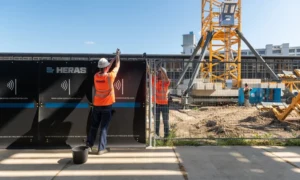Warehouse management systems (WMS) have been an integral part of the supply chain for decades. They are designed to optimize warehouse services by improving inventory accuracy, increasing efficiency, and reducing operational costs. As the world continues to evolve, the future of warehouse management systems will be shaped by technological advancements and changing customer demands. In this blog post, we will discuss the latest trends and predictions for the future of WMS.
What Are The Latest Trends And Predictions Of WMS?
Automation
The use of automation in warehousing and storage services is nothing new. However, as technology advances, we can expect to see even more widespread use of automated systems. According to a report by some researchers, the global warehouse robotics market is expected to reach $6.5 billion by 2023. This growth is being driven by the need for increased efficiency, cost savings, and improved accuracy.
One of the key areas where we can expect to see more automation is in the area of material handling. Automated guided vehicles (AGVs) and autonomous mobile robots (AMRs) are becoming increasingly common in warehouses. These robots can move products throughout the warehouse without the need for human intervention, reducing the need for manual labor and improving efficiency.
Another area where we can expect to see more automation is in the area of order picking. Automated picking systems, such as goods-to-person systems, can improve efficiency by bringing products to the picker, rather than the picker having to travel to the product. These systems can also help reduce the risk of injury, as they can handle heavy or awkward items that may be difficult for human pickers to manage.
Internet of Things (IoT)
The Internet of Things (IoT) has the potential to revolutionize the way warehouses operate. IoT sensors can be used to track the location of products within the warehouse, monitor equipment performance, and provide data about worker activity. This information can be used to optimize warehouse services, reduce downtime, and improve safety.
One of the key benefits of IoT is real-time data. By collecting data from sensors and other connected devices, warehouse managers can quickly identify issues and take action to resolve them. For example, if a piece of equipment is showing signs of wear, IoT sensors can alert maintenance personnel before it fails, reducing the risk of downtime and costly repairs.
IoT can also help improve inventory accuracy. By tracking the location of products in real-time, warehouse managers can quickly identify when products are misplaced or lost, reducing the risk of stockouts and overstocks.
Artificial Intelligence (AI)
Artificial Intelligence (AI) is already being used in a variety of industries to improve efficiency and accuracy. In the warehouse, AI can be used to optimize inventory levels, reduce waste, and improve order fulfillment.
One area where AI can be particularly useful is demand forecasting. By analyzing historical data, AI algorithms can predict future demand more accurately than traditional methods. This can help warehouse managers optimize inventory levels and reduce waste.
AI can also be used to optimize order picking. By analyzing order patterns and suggesting the most efficient routes for pickers to take, AI algorithms can improve efficiency and reduce the time it takes to pick orders.
Robotics
Robotic technology is rapidly advancing, and robots are becoming increasingly sophisticated and adaptable. In the warehouse, robots can be used for a variety of tasks, including picking, packing, and transporting goods.
One area where we can expect to see more robotics is in the area of collaborative robots, or cobots. These robots can work alongside human workers, assisting with tasks such as picking, packing, and transport. This can help reduce the risk of injury, as well as improve efficiency.
Another area where we can expect to see more robotics is in the area of autonomous robots. These robots can navigate the warehouse environment without the need for human intervention, reducing the need for manual labor and improving efficiency.
Cloud-based systems
Cloud-based systems are becoming increasingly popular in the warehouse management systems industry. These systems allow warehouse managers to access real-time data about inventory levels, equipment performance, and worker productivity from any location with an internet connection.
One of the key benefits of cloud-based systems is scalability. Cloud-based systems can easily adapt to changes in warehousing and storage services, such as increased demand or changes in inventory levels. This can help warehouse managers stay agile and responsive to changes in the market.
Cloud-based systems can also improve collaboration between different teams within the warehouse. By providing a centralized platform for communication and data sharing, cloud-based systems can help break down silos and improve collaboration between teams such as logistics, inventory management, and order fulfillment.
Augmented Reality (AR)
Augmented Reality (AR) technology has the potential to revolutionize the way warehouses operate. AR can be used to provide workers with real-time information about inventory levels, product locations, and equipment performance. This information can be overlaid onto the worker’s field of view, providing an intuitive and hands-free way to access information.
AR can also be used to improve training for new workers. By providing a virtual environment for training, workers can learn how to operate equipment and navigate the warehouse in a safe and controlled environment. This can help reduce the risk of accidents and improve worker productivity.
Predictive Analytics
Predictive analytics is a powerful tool that can be used to optimize warehouse operations. By analyzing historical data, predictive analytics algorithms can identify patterns and make predictions about future trends. This can help warehouse managers optimize inventory levels, improve order fulfillment, and reduce waste.
One area where predictive analytics can be particularly useful is in the area of equipment maintenance. By analyzing data about equipment performance, predictive analytics algorithms can predict when equipment is likely to fail and recommend maintenance before a breakdown occurs. This can help reduce downtime and improve equipment longevity.
Conclusion
The future of warehouse management systems is exciting and full of possibilities. Automation, IoT, AI, robotics, cloud-based systems, AR, and predictive analytics are all driving the evolution of warehouse management systems. By embracing these trends and predictions, warehouse managers can stay ahead of the curve and remain competitive in an increasingly complex and fast-paced market. If you are looking for the best and most customized warehousing services look no further than Ethics Express. Contact us now and get customized services that help to coordinate your warehouses effectively ensuring a seamless operation.








































